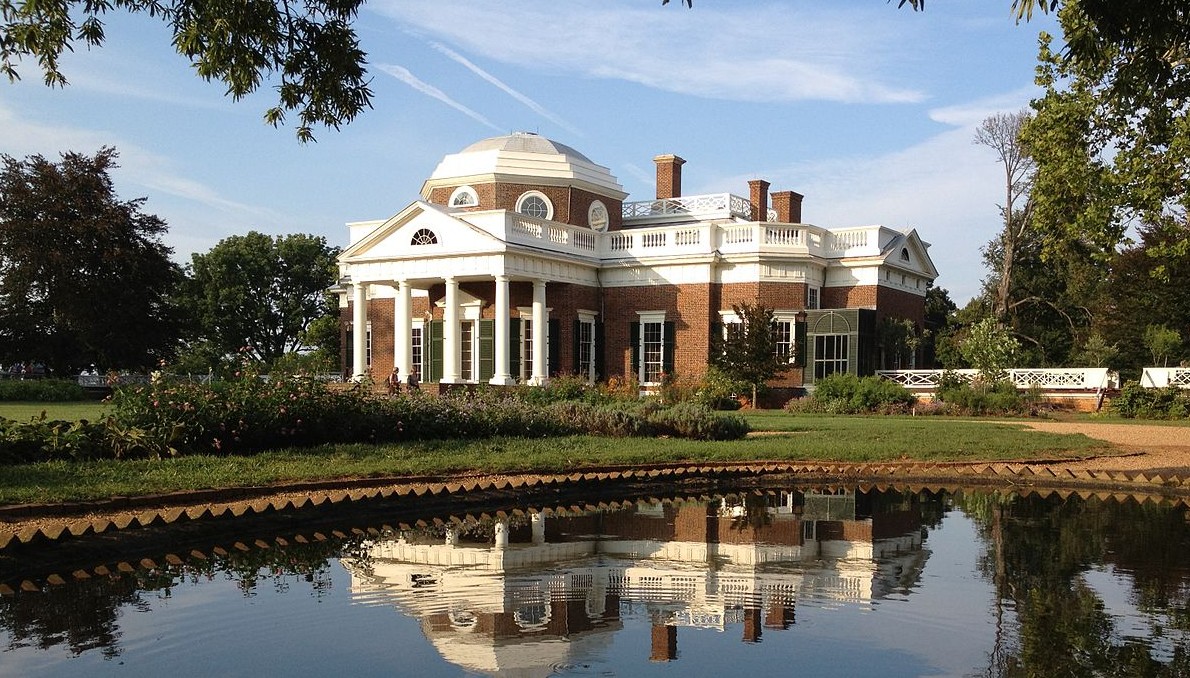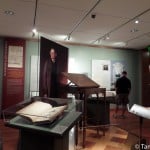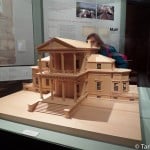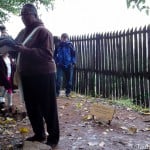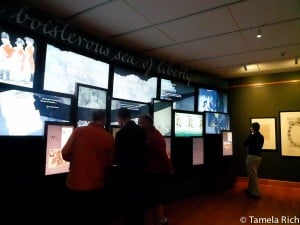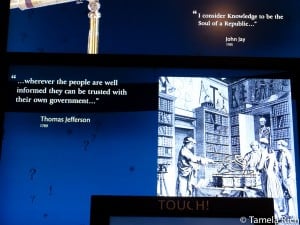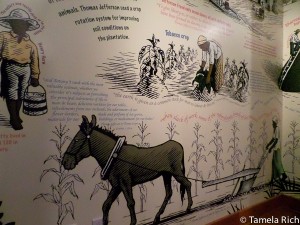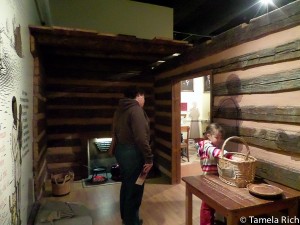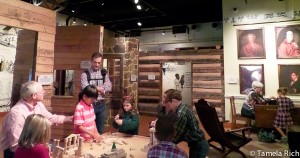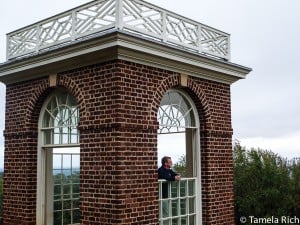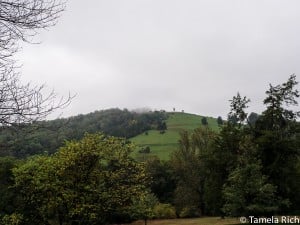This post was updated on April 12, 2016:
Monticello has kindly offered two adult and two children’s visitor passes to the winner of my drawing. Monticello will contact the winner and arrange for the visit.
Drawing will be 5/27/16. No purchase necessary. Scroll to the bottom of this post to enter.
You can also enter on my Charlotte Parent Magazine blog, Travel with Purpose.
Original Post published 3/18/15:
With spring break and summer vacation season upon us, I always recommend that parents place an historical site in the itinerary. It could be a quick pull-over at the geographical center of the continental United States where you get a quick family photo, or it can be a week in Gettysburg to take a deep dive into Civil War history.
If you plan ahead, you can listen to audio books in the family car on the theme of your vacation. They’re a great way to get the kids excited about what they’re about to experience and they beat the heck out of one more replay of a kid movie soundtrack from an adult’s perspective! You can borrow audio books from the public library or buy them from Audible.com (this link will take you to some chiildren’s books on Jefferson).
As part of my continued segment on Fox 46’s Good Day Charlotte, I suggested Monticello (in Charlottesville, Virginia) for spring break.
Why? Because President Thomas Jefferson was interested in every cool thing that excites kids today: paleontology, archeology, plants and animals, weather, secret codes, and ice cream.
Monticello is also where parents and children can learn about, yes, slavery.
Jefferson was at one time the largest slaveholder in Virginia, yet he originally drafted the Declaration of Independence to include strong statements against slavery. Jefferson’s strongest-worded paragraph was voted down by the Congressional Congress, then replaced by watered down language in the final draft.
Should we be talking to our kids about slavery?
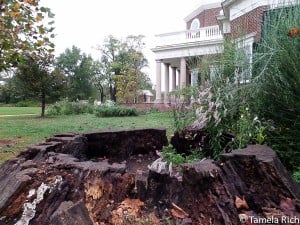
This tree was alive during Jefferson’s lifetime.
What better way to learn about slavery and racism than as a family, where parents can share their values on the matter?
If the thought makes you squeamish, consider our media-drenched culture. Even young children are aware that America’s slave-holding past has cast a long shadow in places like Ferguson, Missouri and in their own hometowns.
Bottom line: If you aren’t talking to your kids about slavery and racism, you can bet someone else is—directly or indirectly. This is why I categorize Monticello “Connect Deep” on my site.
Monticello is the perfect place to explore the roots of racism
I think there’s no better place to learn about our nation’s history with slavery than at Monticello, home of the third president of our country—who is believed to have fathered the children of Sally Hemings, one of his slaves.
Instead of squirming uncomfortably when the subject of slavery comes up, a trip to Monticello offers families a way to discover the subject in age-appropriate ways. The historical site neither sensationalizes nor sugarcoats slavery.
Guided tours, including slave quarters on “Mulberry Row”
These tours are available at Monticello:
- Guided Tour of Monticello’s first floor comes with a Day Pass
- You need the “Behind the Scenes” pass to see the second floor, the dome and other places in the house. Buy your tickets in advance; it sells out quickly
- Guided “Slavery at Monticello” Tours (April-October) comes with a Day Pass
- Guided “Gardens and Grounds” Tours (April-October) comes with a Day Pass
Mulberry Row laborers worked as skilled weavers, spinners, blacksmiths, tinsmiths, nail-makers, carpenters, house joiners, gardeners, stablemen, and domestic servants.
To more fully understand Mulberry Row, home to Jefferson’s enslaved workers, here’s an official website.
Jefferson the Renaissance Man
- This room is dedicated to Jefferson, the architect
- Replica of Monticello
- Interpreter answering questions at the slave quarters, Mulberry Row
There is a great deal more than slavery to discover at Monticello. After all, Jefferson founded the University of Virginia, negotiated the Louisiana Purchase, established the American decimal currency system, and imported plants and animals from around the then-known world.
He is even considered the Father of American Archaeology because he excavated a Native American burial mound near Monticello.
A widower, Jefferson would outlive five of his six children. Visitors will learn about how the children and grandchildren were raised and educated—Jefferson had high standards and expected everyone to keep the kind of daunting schedule and intellectual pursuits that he did.
Historical sites, including Monticello, “go digital and interactive”
Back when we were kids going to an historical site was downright boring. Docents and re-enactors in period dress showed visitors how to shoe a horse or make a mustard poultice, but there was not much more to captivate a young person’s interest. We toured a museum with artifacts in glass cases with typewritten labels held in place by push pins.
What kid didn’t hate that?
I’ve visited historical sites in 49 states and Monticello is an example of the future. It offers plenty of kid-centric activities and lots of interactive displays.
Entering the main galleries, visitors are greeted by a wall of 21 flat-panel LCD screens, including seven interactive touch screens (pictured below). This gallery houses the “Sea of Liberty,” which is also an impressive website that you can use to take your visit to Monticello back home with you.
Note the word “Touch” in the one to the right. You can see larger versions of all the photos in this post by clicking on them.
- This panel of ever-changing thematic displays greets Monticello visitors
- Not the invitation to “TOUCH” on the screen on the bottom
Monticello’s programs for kids
The Griffin Discovery Room is where kids aged 6-12 will happily spend time exploring all things Jefferson:
- Writing on a polygraph machine based on the one Jefferson owned
- Learning how to weave
- Trying on replicas of 18th-century clothes
- Touching a mastodon’s jawbone,
- Creating secret codes on a wheel cipher based on Jefferson’s design
- Touring a replica of a slave cabin from Mulberry Row (pictured center-below)
The activities are self-directed and will also be enjoyed by adults—but restrain yourselves!
- Life on Jefferson’s plantation
- This is a replica of a slave dwelling
- Kids learn about architecture
Older children will enjoy the room’s computers with programs that enable visitors to design a house with choices of building materials, styles of windows, domes, columns, pediments, balustrades, etc.
Other seasonal activities are available at the Mountain Top Hands-On Activity Center.
Resources for kids
Plan ahead by downloading a free iPad app to engage children, ages 3-7 in the story of America’s Founding Fathers. The app takes young children on a virtual field trip to Monticello.
Sea of Liberty (mentioned above) interactive website allows teachers and students the opportunity to explore and create digital projects with documents, letters, and images related to ideas of liberty, freedom, and self-governance.
Download this guide and see Monticello through the eyes of Jefferson’s granddaughter Cornelia.
The Jefferson Gardens
Monticello was the first weather observation center in America, run by Jefferson himself. He was an obsessive list maker, and weather was one of his obsessions. For nearly 50 years he took daily notes of weather: temperature, rain fall, barometric pressure, wind direction. He developed a network of others who did the same and they compared data.
He was responsible for the first debate on global warming in history, predicting that the climate of Virginia would no longer support the growing of tobacco.
- Jefferson’s Pavilion, overlooking his beloved vegetable garden
- Heritage cabbage, which grew at Monticello during Jefferson’s lifetime
- View from Monticello on a rainy October day
When Matt and I toured Monticello, we met gardening enthusiasts who’d come from around the world to learn more about Jefferson’s horticulture.
Jefferson loved farming and experimented with 330 varieties of more than 70 species of vegetables from around the world. Remember, Jefferson was responsible for the Louisiana Purchase; he instructed Lewis and Clark to send back as many plants and animals as possible so that he could study and catalog them. Many of those plants are still cultivated at Monticello using what we now call “organic” means.
Jefferson documented his successes and failures in his Garden Book, noting for instance the dates when seeds were planted, when leaves appeared, and when their fruits came “to table.”
Jefferson had left behind his plan for restoring the gardens. That guide was found in 1938, and the result is on your Monticello tour.
Our visit on a dreary October day didn’t make for the best photos, but that’s okay. I learned a great deal and thought deep thoughts about America and humanity. We have a long way to go, but we’ve also come a long way.
